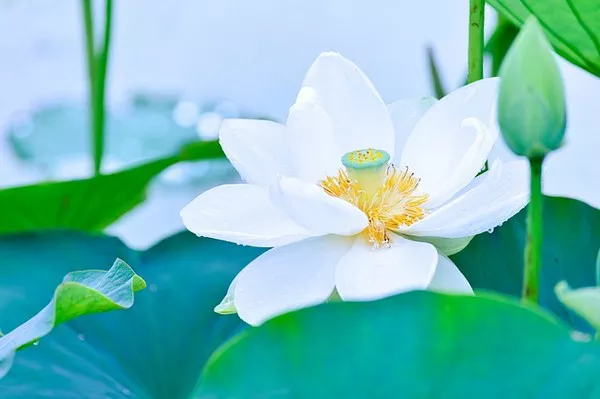The lotus flower, with its exquisite beauty and rich cultural significance, has captivated hearts and minds across various civilizations for centuries. Renowned for its resilience, purity, and spiritual depth, the lotus holds a unique place in the realms of art, religion, and philosophy. As we delve into the multifaceted meanings associated with this remarkable flower, we uncover a tapestry of symbolism that transcends borders and resonates with the human spirit.
Historical and Cultural Roots:
The lotus has deep historical roots, featuring prominently in the mythologies and religious texts of ancient civilizations. In Hinduism, the lotus holds particular significance, representing purity and divine beauty. The goddess Lakshmi, associated with wealth and prosperity, is often depicted seated on a blossoming lotus, emphasizing the flower’s connection to abundance.
Similarly, in ancient Egyptian culture, the lotus was a symbol of rebirth and the sun. The flower’s daily cycle of closing and reopening, emerging from the murky waters of the Nile, mirrored the sun’s journey across the sky. This association with renewal and regeneration elevated the lotus to a sacred status in Egyptian art and religious practices.
Buddhism and the Lotus Sutra:
One of the most profound and enduring connections to the lotus is found in Buddhism, where the flower is a central symbol in the Lotus Sutra. This scripture, revered by various Buddhist traditions, uses the lotus as a metaphor for the journey to enlightenment. The lotus, rooted in muddy waters but emerging unstained and pure, mirrors the spiritual path of individuals who strive for enlightenment amidst the challenges of life.
The different stages of the lotus, from bud to full bloom, symbolize the various phases of spiritual awakening. The closed bud represents the potential for enlightenment, while the fully open blossom signifies the attainment of wisdom and self-realization. This metaphor has inspired countless Buddhist practitioners to embark on their own journey towards enlightenment, drawing strength from the lotus’s transformative symbolism.
The Lotus in Eastern Art:
Beyond its religious connotations, the lotus has left an indelible mark on Eastern art, serving as a muse for poets, painters, and sculptors alike. In traditional Chinese art, the lotus is often portrayed in serene landscapes, symbolizing purity, elegance, and the pursuit of higher consciousness. The intricate depictions of lotus blossoms in delicate brushstrokes convey not just the physical beauty of the flower but also the spiritual aspirations it embodies.
Japanese art similarly celebrates the lotus, integrating it into various art forms such as ikebana (flower arranging) and ukiyo-e (woodblock printing). The lotus’s presence in these art forms reflects a harmonious blending of nature, beauty, and profound symbolism, illustrating the flower’s enduring cultural significance.
The Lotus as a Universal Symbol:
While the lotus has deep roots in Eastern cultures, its symbolism has transcended geographical boundaries, finding resonance in Western societies as well. As globalization has fostered a greater exchange of ideas and beliefs, the lotus has become a universal symbol of beauty, resilience, and spiritual growth.
In contemporary contexts, the lotus often appears as a motif in art, jewelry, and even popular culture. Its graceful form and rich symbolism make it a popular choice for those seeking to convey deeper meanings in their creative expressions. From tattoos to fashion, the lotus continues to captivate and inspire individuals across diverse backgrounds.
Resilience Amidst Adversity:
One of the most compelling aspects of the lotus’s symbolism is its association with resilience in the face of adversity. The lotus’s ability to thrive in murky waters, emerging unsoiled and pristine, serves as a powerful metaphor for the human spirit’s capacity to overcome challenges and bloom despite unfavorable conditions.
In times of personal struggle or societal upheaval, the lotus’s symbolism becomes a source of solace and inspiration. Its message is clear: just as the lotus rises above the mud to reach for the sun, individuals can transcend difficulties and emerge stronger, wiser, and more beautiful.
The Lotus in Meditation and Yoga:
The lotus’s profound symbolism extends to the realms of meditation and yoga, where its imagery is often invoked to deepen spiritual practices. The lotus position, a cross-legged sitting posture synonymous with meditation, reflects the flower’s serene and grounded nature. Practitioners adopt this posture to cultivate a sense of inner calm, balance, and connection to the spiritual realm.
Meditative visualizations involving the lotus often center on the idea of the chakras, energy centers within the body. The lotus is associated with the crown chakra, representing higher consciousness and spiritualawakening. By visualizing the lotus blossoming at the crown of the head, individuals seek to align their energies and attain a state of heightened awareness.
Conclusion:
The lotus flower, with its rich tapestry of symbolism, transcends time and culture to embody universal themes of purity, resilience, and spiritual awakening. From its ancient roots in Eastern religions to its pervasive presence in contemporary art and popular culture, the lotus continues to inspire and uplift individuals across the globe.
As we contemplate the profound meanings embedded in the lotus, we are reminded of our shared humanity and the collective journey towards enlightenment. The lotus, in all its beauty and symbolism, invites us to rise above life’s challenges, embrace personal growth, and strive for the higher ideals that unite us on our spiritual quest.


